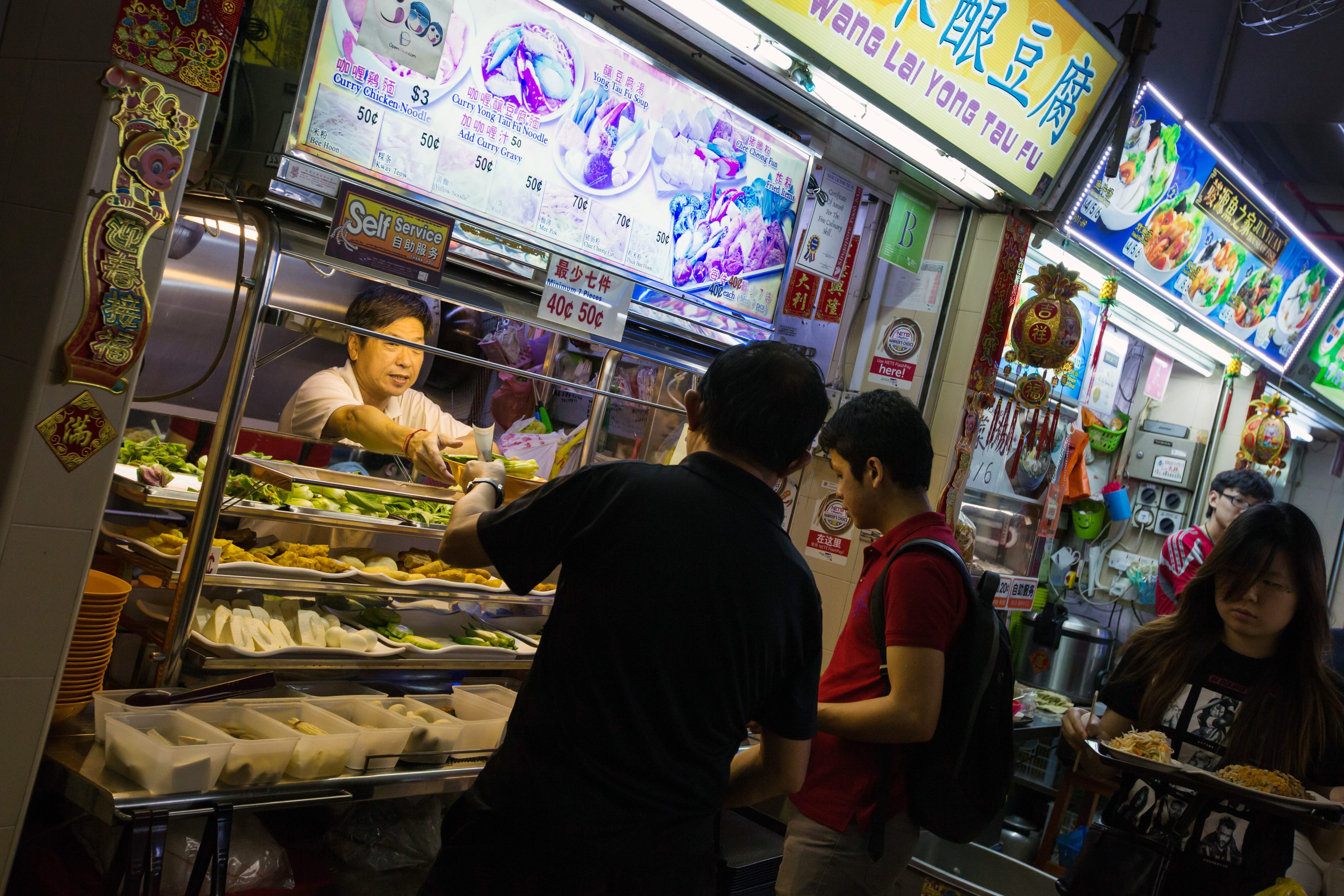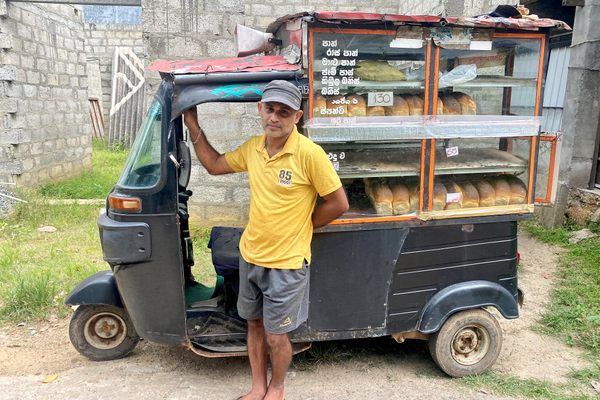How Singapore’s World-Famous Street Food Could Disappear
Hawkers are retiring without successors, taking classic dishes with them.

Lunchtime, 12 p.m. Hordes of office workers stream out of air-conditioned glass buildings in the heart of Singapore’s Central Business District toward Amoy Street Hawker Centre. There, they wait in snaking queues at rows of stalls, each operated by a hawker who often specialises in just one dish, such as char siew (Cantonese barbecued pork) or rojak (an assorted fruit and vegetable salad dish, doused with a sweet and spicy peanut sauce). The smell of spices, fried garlic, and caramelized meat mingles with the dark aroma of kopi tarik (sweet and rich pulled coffee), and the sounds are a melody of conversation, noodles being stirred, and hurried chops of the cleaver.
Singapore has often been described as a food paradise, and its hawker centres, of which there are more than 100, are the city-state’s most visible symbol of its highly democratic culinary scene. Tourists and visiting chefs head to the street markets to feast on Singaporean foods, whose multi-ethnic influences reflect the population: Chinese, Malay, and Indian. But with a plate of chicken rice costing around $3, hawker fare is a staple diet for a majority of Singaporeans—affordable, accessible, and delicious.
Despite this celebration of hawker food by both locals and visitors, beloved dishes are in danger of disappearing, threatening a crucial part of local culture and identity. Experienced hawkers are in their twilight years, and are retiring without passing their knowledge and skills to a successor.

Hawking first became a popular career option in the 1950s and 1960s, during Singapore’s post-war years, as it provided informal employment for residents during a time when jobs were scarce and the city was poor. By the end of the 1960s, roughly 24,000 hawkers, selling delicious and affordable street grub, were feeding a population of 1.7 million.
But the unregulated expansion of hawking led to hygiene and congestion issues. Hawkers roved open spaces and streets, selling home-cooked wares. The combination of diverse offerings—Javanese tempeh, Cantonese congees, Teochew porridges—that could be obtained instantly made them popular. But one such area, Ellenborough Market, which was called Teochew Market due to hawkers in the area, was razed by a fire in 1968, and food poisoning cases were common.
The government intervened, grouping hawkers in designated wet markets, or pasars in the Malay language. The open-air buildings, with individual stalls and designated sitting areas, became known as hawker centres. By the mid-1980s, the roughly 140 hawker centres across Singapore had become an institution. The number of hawkers continued to grow, as did their renown. In 2016, Chan Hon Meng’s soya chicken rice, which costs less than three dollars, earned him a Michelin star. But ask any Singaporean, and they’ll gladly debate which stall sells the best hokkien mee (wok fried prawn noodles) or laksa.
When Singapore’s hawker scene first developed, the city was in the process of rapidly transforming from a manufacturing hub to a well-functioning, cosmopolitan city. Decades of booming growth have since created millionaires (and inequality), an enviable skyline, and a pricey real estate market, making the continued existence of world-class food for three dollars a minor miracle. But the contradiction may not be able to last much longer.

One major threat to hawkers is competition from mall food courts—even though their offerings are less appealing. Unlike in hawker centres, where the food is typically cooked by self-employed stallholders, food court staff are hired, temporary, and given few training opportunities. But Singapore is a city so hot and humid that Lee Kuan Yew, the longtime prime minister, described air conditioning as the most important factor in the country’s growth. Shopping malls are curated for comfort and convenience—one can shop for groceries, enjoy an afternoon kopi, and find fusion burritos, all under one climate-controlled roof.
Yet the greatest challenge is that fewer cooks are taking up the hawker trade, which is an increasingly expensive proposition. The government owns the centres and auctions off leases for open spaces, with popular areas going for a premium. But after outbidding others, new hawkers have to compete with veterans, who pay less for their real estate—a legacy of the intervention that moved hawkers off the streets and into markets in the 1960s. Given the opportunities provided by Singapore’s economic growth, younger generations are also deterred by the long hours, physical demands, and less-than-desirable pay.
Consider the simple kaya toast found at Ah Seng Hainam coffee, an institution tucked away in Amoy Street Hawker Centre. The locale has been serving a Hainanese-style local breakfast since the 1950s, which typically includes kaya toast, two soft boiled eggs, and Nanyang coffee. After 60 years, owner Wong Ah Loke still insists on making breakfast the traditional way. He and his wife go to the stall at 4 a.m. every day to set up a charcoal fire, using the embers to warm up toast and heat the coffee percolators. While they no longer roast their coffee beans, they still make kaya from scratch, mixing coconut milk, eggs, sugar, and pandan leaf to make the distinctive green jam. Along with other touches, such as the charcoal embers, and the coffee style of mixing robusta beans with margarine, sugar, and maize, this is why customers keep coming to their stall.

If new owners take shortcuts, critical facets of hawker culture will be chipped away. KF Seetoh, founder of the hawker food guide Makansutra, laments that “new hawkers are hard to find, few and far between.” Already several dishes, such as Cantonese loh kai yik (stewed chicken wings) and the Hainanese yi buah (sweet glutinous rice cakes, with coconut fillings), are in danger of dying out. “More food will disappear as skills are lost,” says Seetoh, who notes that new hawkers want to sell what’s easy, focusing on quantity over quality. ”It’s about business today, not dedication and passion.”
The Singapore government is conscious of the threats to hawker culture. Earlier this year, Singapore’s prime minister, Lee Hsien Loong, announced a bid to make hawker centres places of protected cultural heritage under UNESCO. Other initiatives aim to educate the younger generation and attract them to the hawker trade. There are also calls for a new hawker centre management model that reduces capital costs for hawkers and is oriented around their role providing affordable meals to the public.
This phenomenon isn’t unique to Singapore—other cities, such as Hong Kong, are seeing street market culture disappear. But hawkers have long been symbols of resilience. Wong is optimistic that future generations will continue their traditions, even if they tweak their practices to adapt with the times. “As long as one does [one’s work] well and continues to persist,” he tells me, “traditions and skills will continue to be preserved and passed on.”
Gastro Obscura covers the world’s most wondrous food and drink.
Sign up for our email, delivered twice a week.




























Follow us on Twitter to get the latest on the world's hidden wonders.
Like us on Facebook to get the latest on the world's hidden wonders.
Follow us on Twitter Like us on Facebook